- Home
- New Kyurizukai
- Digital Architecture
from Keio's Faculty of Science and Technology
Digital Architecture
from Keio's Faculty of Science and Technology
In quest of digital technology
that can fully convey versatile information
Accumulating various experiences and making steady observations foster the ability to scrutinize information
Dr. Kaneko talked about his surprising childhood, when he had longed for the world of spies. As such, he has sharp eyes for scrutinizing information. At present, he is making all-out efforts to address problems of information (content) distribution, saying that our world will become far richer and more exciting only if we can handle it properly.
Kunitake Kaneko
Born in Kagawa Prefecture, Dr. Kaneko specializes in application-oriented networking, focusing on networking of digital data that allows effective use of digital data. After graduating from the University of Tokyo in 2001, he completed the doctorate course at the Graduate School of Information Science and Technology of the same university in 2006; doctorate degree (Ph.D.). After serving as a Research Assistant at the Graduate School of Frontier Sciences, he joined Keio University in September 2006 as Assistant Professor for Research Institute for Digital Media and Content (DMC Institute). In April 2012, Dr. Kaneko assumed the current post while concurrently serving as a Researcher for DMC Institute.
The Research
Assistant Professor Kunitake Kaneko is featured in this issue, whose field of research focuses on effective use of ubiquitous digital contents.
Aiming to create an advanced society that can make effective use of digital contents – the common property of all humankind
From computer network to digital content network
Potential value of Big Data and other digital contents is now a focus of worldwide attention. For digital content to convey its value to potential users, it is essential to make known existing usages of such content. This requires a wide variety of technical developments. Dr. Kaneko regards the life cycle of digital content – from its creation until its death– as something like that of humans. He studies digital infrastructures to support the life cycle with network technologies through practical applications development (Fig. 1).
Stage 1 Viewing 4K broadcasts at home
Visit an electric store in town and you can see 4K ultra high-definition images, which will impress you with their utter beauty and overwhelming impact. It is said that Japanese people will be able to enjoy such wonderful TV broadcasts at home by 2020 Tokyo Olympics/ Paralympics. But a number of technical problems must be solved before this becomes a reality.
After completing his doctoral program at the University of Tokyo, Dr. Kaneko joined Keio University’s Research Institute for Digital Media and Content (DMC) in 2006, when he began studying network technologies capable of delivering largecapacity digital content in anticipation of an era of 4K broadcasts over networks.
Dr. Kaneko remarks in retrospect, “Computers in those days lacked the computation power that modern PCs have. This made it relatively easy for me to clearly identify the problems involved in handling large-capacity digital content. Through experiencing many troubles, I found a number of problems.” He undertook the study without taking it too seriously. In fact, at the beginning he assumed that there would be no significant difference between smalland large-volume data in the way we handle them. But contrary to his initial expectation, he came to realize that they were totally different.
The system known as Media Operations on Networks (MOON) was inspired by the hard-earned results of this early study. MOON enables large-volume data sharing over networks using dozens of inexpensive computers. Even in households without a high-quality, highly expensive large-capacity network, MOON can offer large-capacity content delivering performance comparable in quality and price to currently available networks. What’s more, it can respond flexibly to increase or decrease its capacity according to the viewer population.
The proposal of a method for large capacity communications using inexpensive computers and networks and proving it feasible was a breakthrough achievement especially when the majority of researchers were beginning to handle large-volume digital content using powerful servers and quality controlled networks.
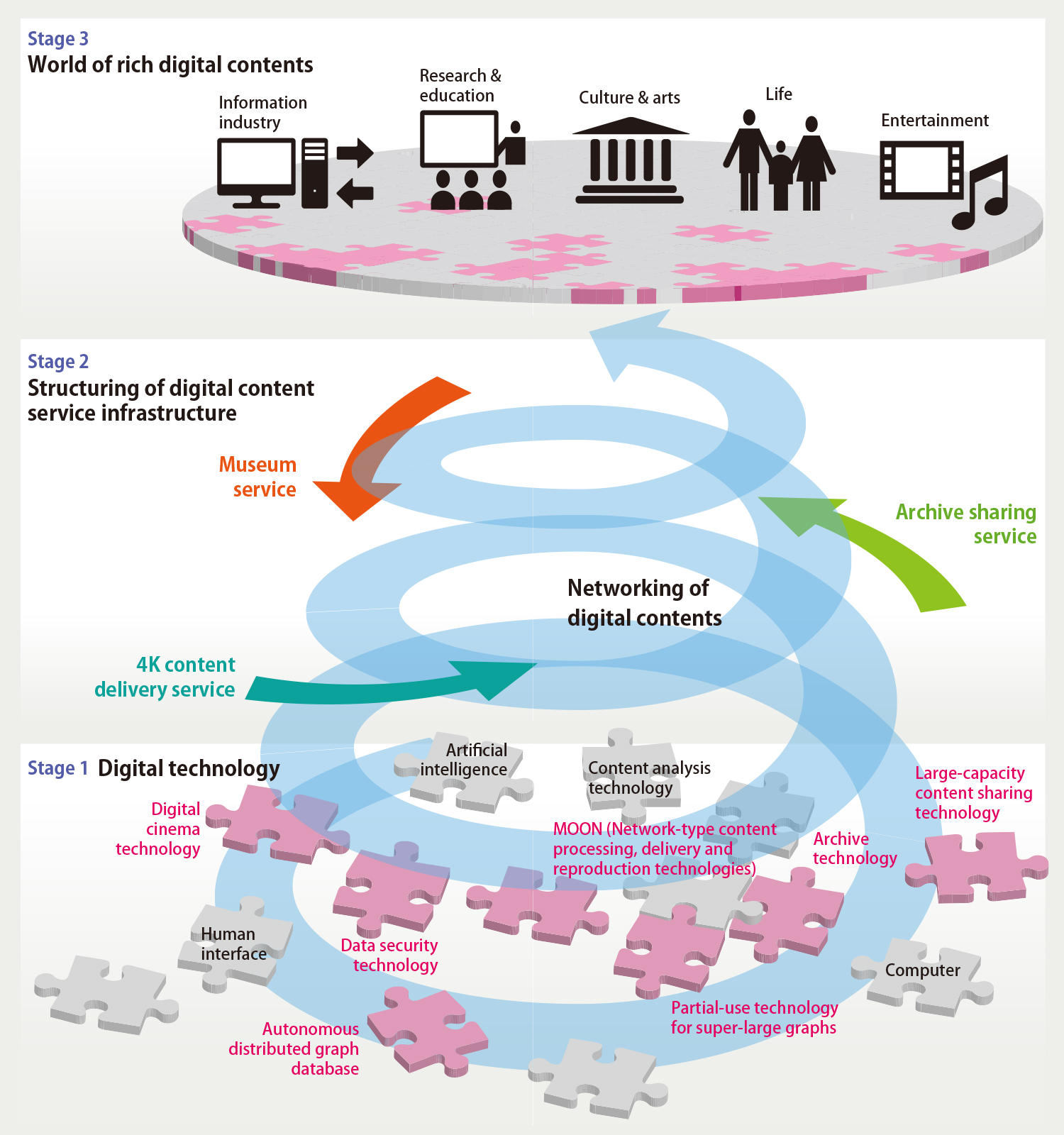
Fig.1 Dr. Kaneko’s approach to research
Dr. Kaneko’s research targets (red pieces) shifted from network of computers to that of content (data). And now he focuses on designing a computer network for the network of content.
From Stage 1 to Stage 2 Creating service-conscious digital technologies
Dr. Kaneko’s research endeavors are not confined to the development of network technologies. He says, “A network that functions properly means that all users use the network under the same rules. And the usefulness of a network increases dramatically as the network scale grows larger. As we focus on network technologies, therefore, we naturally consider the expected services and content, which leads us to create rules so that they maximize the network scale.” No matter what purposes they may be used for, it is often the case that digital technologies share essential functions. That said, random combination of functions would not work. In designing network, we should take various content and services into account and find the very requirements that could serve as their common minimum denominators.
Dr. Kaneko continues, “In my student days when I was engaged in network studies, I pursued studies to find and solve network problems f rom the viewpoints of pure network technologies. When I completed my doctoral program, Prof. Tomonori Aoyama, my adviser, encouraged me to approach network technologies from the perspective of ‘How users wish to use it’.” Inspired by this advice, who was well aware of the limitations of merely studying network technologies, Dr. Kaneko decided to change the direction of his study to network architecture design, much needed by new generations of network services.
After taking up a post at DMC, Dr. Kaneko changed his approach in addressing network technologies by considering the perspective of application services worthy of networking. The development of network technologies for 4K broadcasts nurtured a perspective of application services, which led to an awareness of a new problem as to what really drives effective utilization of 4K content.
Stage 2 Networking of digital content
Upon assuming a post as an assistant professoratthe Department of Information and Computer Science at Keio, Dr. Kaneko launched a project to develop a digital museum. Keio has a wealth of historically valuable materials. Although efforts have been made to digitalize these materials, little has been utilized to date.
To deal with this situation, Dr. Kaneko initiated the Museum of Shared and Interactive Cataloguing (MoSaIC) project. The foremost feature of this project lies in the technology developed by him that can “retrieve, from a certain content, other related contents without the use of keywords” (Fig. 2).
When one searches for a content, it is usually the case that language such as keywords intervenes, as in searches on Google. Dr. Kaneko, however, decided to use simple line-linking between the related contents instead of languagebased text keying. By doing so we may not be able to see why these contents are related, but with the absence of ambiguity inherent in language we can be sure that certain relations do exist between them.
Once a certain content is chosen, line-linked contents are presented one after another, which can lead to new discoveries. This is the strength of the line-linking system. If any one of such new discoveries catches your attention, then you can examine it separately to identify the relationship between the contents concerned. Indication of relationship thus helps to expand the world of content users.
The work of linking content with lines is still being done manually today, but once it is automated thanks to advances in research, digital content all over the world will be linked together like a network. It will thus trigger an explosive increase in the number of new discoveries.
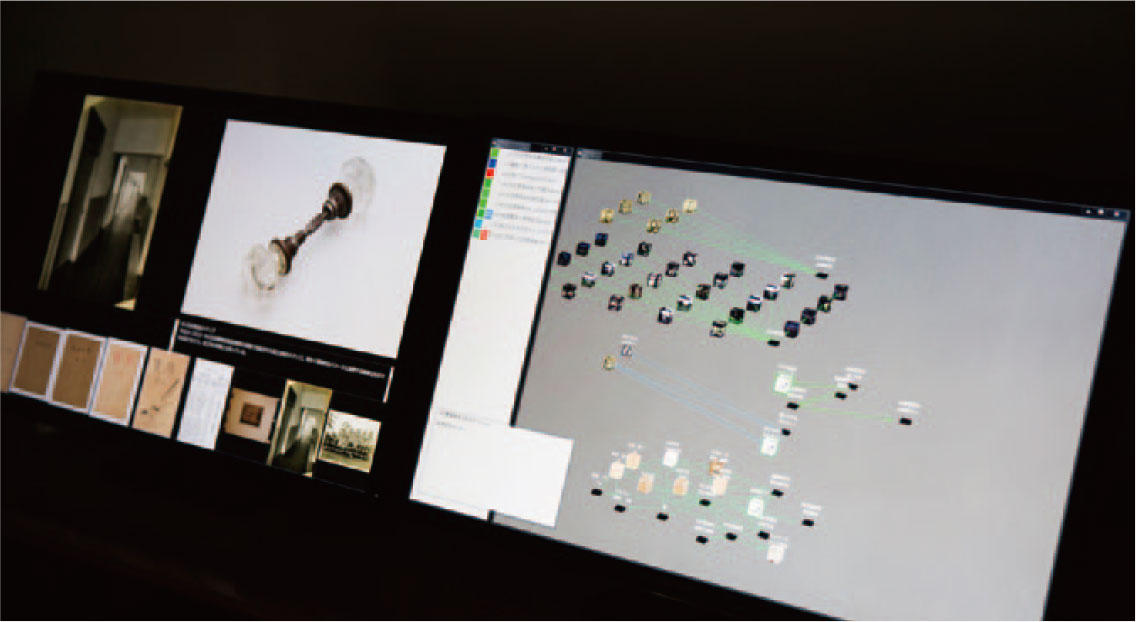
Fig. 2 Virtual museum based on MoSaIC
With the help of MoSaIC functions, it is possible to create “Your own museum space” by arranging and displaying exhibits according to your personal knowledge, feelings, and tastes. Combination of these museum spaces enables the creation of virtual museums that can be realized only by digital technologies.
Stage 3 Enriching the world of digital content
Besides the foregoing research activities, the range of Dr. Kaneko’s involvements with digital content infrastructures is remarkably wide, including a contract with Hollywood to verify functions and performances of digital cinema equipment, and drafting the standard of digital archives. This is because, in order to pursue projects and studies relating to effective use of digital content in a comprehensive manner, he thinks it necessary to grasp each and every problem of digital content that we are now facing. He also believes that we won’t be able to enhance and enrich our digital society without creating technologies capable of freely using enormous amount of digital content –both already existing and to be amassed in the future.
Dr. Kaneko’s world of research is one of a kind in the world. Using it as the core, DMC at Keio University plans to create a digital museum. A point where arts and sciences meet, DMC is blessed with a superb research environment that allows participants to engage in a wide range of pursuits, from networks to content. We look forward to seeing new, exciting values coming from DMC.
Interview
Assistant Professor Kunitake Kaneko
Fond of imagining hidden systems
A child who liked to make observations
I was a type of boy who would keep watching movements of an excavator at a construction site endlessly. To tell the truth, even now I still have this habit and like to watch people coming and going. Though I dare not talk to passers-by, I keep watching them while wondering, “What are they doing?” or “What are they doing it for?”
For example, suppose I noticed airline staff members, who had been at the check-in counter, were now found standing at the boarding gate, I would wonder, “At what timing did they move to the boarding gate and why at that particular timing?” What I actually see is only a portion of their entire movement, but I like to think about the meaning it has within the entire system. It is intriguing because I sometimes can have a glimpse into differences between airline companies.
Becoming a “007” – my dream
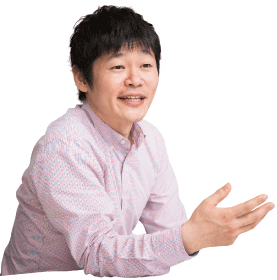
When I was a schoolboy, I once wanted to become a spy. Reading a book entitled “Best 50 Detectives of the World” or something like that was a trigger. Of the 50 heroes featured in the book, the cool 007 was my favorite. As there were no such books as “how to become a spy”, I seriously thought I would have to master all the abilities required of competent spies on my own. Driven by this ambition, I read many books to acquire the needed knowledge, physical strength and emotion control powers, and tried them by myself. Since spy activity is basically supposed to take place in foreign countries, spies would need the ability to understand the given situation correctly using a limited amount of information. So I wondered how I could acquire the ability to judge correctly whether the information is true or not.
With respect to my attitude toward information authenticity, I feel I was somewhat influenced by my parents’ education. In my childhood, I was surrounded by illustrated reference books and encyclopedias at home. Naturally, I compared these books. Some pictorial books were written this way and others that way. I even found wrong information.
What brought you to Keio University?
Prof. Tomonori Aoyama, my advisor at the University of Tokyo, had been engaged in the development of 4K technologies at NTT. When I was in the second year of my doctoral program, he asked me about my future career. “I have no specific idea yet”, was my answer. Prof. Aoyama said, “Then let me think about it, OK?” Soon after that, at an international conference, Prof. Aoyama introduced me to a professor of Keio University, who encouraged me to come to Keio.
This is how I came to work for Keio’s Research Institute for Digital Media and Content in 2006. In April 2012, I additionally took up a post as Assistant Professor in the Faculty of Science and Technology.
I’m probably the only one in the world who is devoted to designing a hyper-scale information network that links digital data from the past to the present and from the East to the West, as well as thoroughly thinking about services evolving out of such network and IT technologies supporting it.
Until realizing the blittleness of common sense
My experience overseas – undermined preconceptions and assumptions
As a third grader in elementary school, I accompanied my father, a biologist (morphological taxonomy), staying for one month in the United Kingdom and three months in the United States. Until then, I had a bias against airplanes due to accidents that occurred from time to time, saying it’s strange that such a heavy object could fly with people on board. But this view disappeared when I flew on a YS-11 (the now retired propeller-driven passenger plane made in Japan) and jetliners to visit the U.K. “Air travel is not so bad” – this was the impression of my first flight. I was also surprised to find how clouds were soft. We visited the U.K. via Moscow, where I was shocked to find people speaking a “totally foreign” language. At the same time, I was also surprised to find my father capable of communicating with these people. We brought a radio with us from Japan. As I switched it on in the U.K., to my great surprise, the language on air was English! In Japan, the radio only spoke in Japanese, but now it spoke in the local language, which was truly amazing. Social systems, cultures, products…all were different from those of Japan. At the same time, I also began to feel a yearning for British gentlemen.
Limits of knowledge
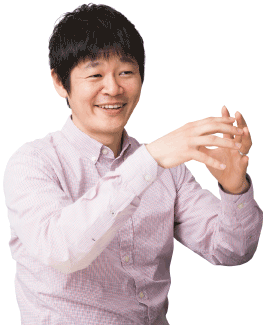
The period of my overseas stay was only four months, so I did not attend a local school; I would study at home one day and go out the next day. For days of outing, my mother, my elder brother and I took turns to choose places to visit. One day when traveling on a bus together with my brother, who was a fifth grader in elementary school, we got lost. I consulted a Japanese-English dictionary at hand and found the words “here” (“koko” in Japanese) and “where” (“doko” in Japanese) but it didn’t show how to use these words. Although I carried this dictionary with me throughout the trip, I found it useless after all. Nevertheless, we were truly grateful to the bus driver who was kind and patient enough to deal with the two small boys who kept speaking only “here” and “where” until he could somehow understand us.
When I returned to Japan, my classmates told me, “Your mind is out of focus due to the overseas stay.” But that overseas stay gave me a lot of rewarding experiences.
Reach to the research topics
How to choose your expertise
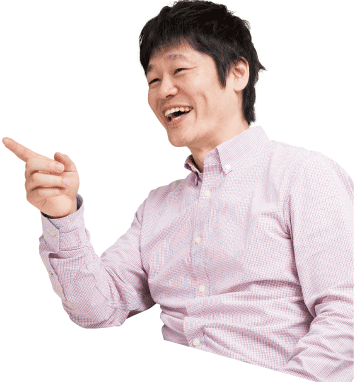
To tell the truth, it was not my initial intention to focus on the network world. As a high school student, I was interested in aeronautical and space sciences. In my elementary and junior high school days, unlike today, rocket launching was still a rare event. Naturally I yearned for space travel.
Although I chose the University of Tokyo to study aeronautical sciences, a year after, I switched my course to information and communication engineering because I didn’t like physics. Moreover, I was attracted to radio communication and Internet. When I was in the first year of high school, I got a short-wave radio. Taking this opportunity, I made an FM antenna on my own using two curtain rails at home and enjoyed FM broadcasts from Osaka. When a special ionosphere known as the sporadic E layer was formed in the upper sky, I happened to receive broadcasts from Hokkaido, which was otherwise unavailable. Thanks to these events, I was captivated by mysteries of radio waves. In those days, I used to write a letter to the U.K to request BBC’s latest short-wave broadcast programs, which I would receive a few months later. But these programs soon became instantly available via the BBC website, which was an exciting development.
Recalling these events, I decided to major in information and communication technology, which dealt with information exchange via radio and the Internet. I chose “Mobile Internet” as the topic of my graduation thesis, “Mobility Support” for master’s thesis and “Network Architecture” for my doctoral thesis.
Transition of research topics
I encountered a number of challenges as I was assigned to DMC and began 4K visual transmission tests. Although I strove to solve these problems by using every possible network technology that I had learned during my student days, it was often the case that they didn’t work. People around me (who are not network specialists) even advised me, “You don’t have to stick to network, do you?” I was made to think seriously about the significance and value of network. On the other hand, even if I successfully create a technology capable of delivering 4K high-definition visuals, the technology will be of no practical use unless there are people who wish to access them. Therefore, I came to think about creating an attractive world that would encourage viewers to access 4K content.
The current situation is this: the more people can create digital information, the more easily such information gets buried. Therefore, it is essential that by linking as many contents as possible we offer opportunities to expose these contents to viewers so that they can easily access them. In fact, I find this vital to network digital content. The network I have in mind is trillions of times larger in scale than the current Internet. Then, what mechanisms should this network of tremendous content scale have in order to effectively facilitate scrutiny of information? This has become my current research topic.
What is scrutiny of information?
First and foremost, you must get to the bottom of what is really true. You may believe something as being correct, saying, “This is what my teacher taught me”, “This is written in my textbook”, or “This is what I’ve already experienced.” But you shouldn’t take all of their authenticity for granted. It may be true in one facet of a certain phenomenon, but you should examine thoroughly whether you can find the same facet in the phenomenon that you are facing now or whether it is worth finding it in the first place. You should continue seeking the truth at all times while making the most of the knowledge you have gained in the past to seek for a relevant facet of the phenomenon. Never be content with looking at one facet of a thing. The more facets you have to explore, the closer you get to the truth. Of course, experiencing failure is inevitable if you are in an ongoing quest of truth. But if the failure allows you to discover a new facet of a thing, your quest will surely lead to a higher stage.
In order to acquire knowledge from past experiences, it is essential that you accumulate various experiences and make thorough observations and inquiries.
Some words from students
Through my experience working part-time as a supporting staff of IT equipment repair, I wished to deepen my knowledge of network and chose to study at Dr. Kaneko’s lab. My generation takes Internet connection for granted, but I think it is important to understand each factor that allows the Internet to function properly. From Dr. Kaneko, I’ve learned to identify problems in the world and thinking about how to solve them. Meanwhile, Dr. Kaneko is a friendly teacher who always cares about us including our private lives.
Some words from Dr. Mayumi Ikeda (Dr. Kaneko’s wife)
I teach English and liberal arts at the Faculty of Science and Technology. I became a member of DMC as I had been involved in a project to digitize the Gutenberg Bible owned by Keio University. Currently I’m engaged in creating museum contents under the MoSaIC project led by my husband. As a mother of a nine-month-old boy, I’m struggling with childrearing. My husband is an excellent father, who is in charge of taking the baby to and from the nursery school and bathing him everyday. But, he has never tried to make baby food for some reason although he is a good cook…
(Reporter & text writer: Akiko Ikeda)


